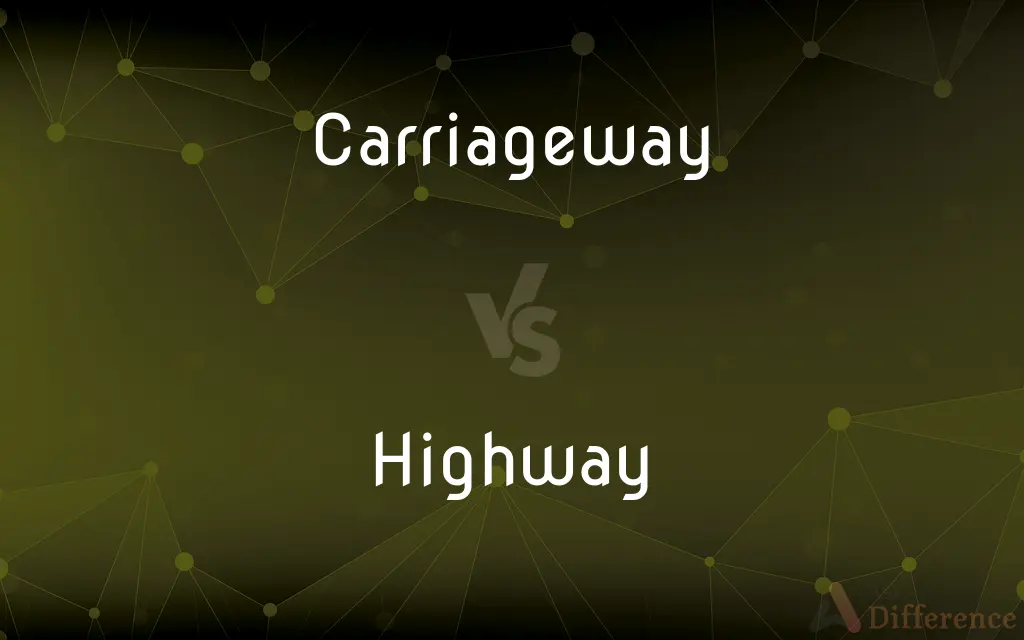Carriageway vs. Highway — What's the Difference?
By Fiza Rafique & Urooj Arif — Updated on March 12, 2024
Carriageways are specific lanes or tracks on a road meant for a single line of traffic, whereas highways are broad roads designed for fast-moving, long-distance travel.

Difference Between Carriageway and Highway
Table of Contents
ADVERTISEMENT
Key Differences
A carriageway refers to one side of a road where vehicles travel in one or more lanes in the same direction, specifically designed to manage traffic flow efficiently. It's a term more commonly used in the UK and some Commonwealth countries to describe the part of the road that cars actually travel on. A highway, on the other hand, is a general term for any major public road, usually connecting cities and towns. Highways are designed for fast travel and can include multiple carriageways, often featuring limited access points to maintain speed and efficiency.
Each direction of traffic is often separated by a median or central reservation, and multiple carriageways on the same road facilitate organized, safer traffic movement. In many regions, highways are synonymous with expressways, freeways, or motorways, though the exact definition can vary by jurisdiction. Highways are key infrastructure in facilitating regional and national commerce and travel.
Carriageways and highways serve different but complementary purposes in road infrastructure. While the carriageway is a part of the road itself, delineating specific lanes for traffic, a highway refers to a broader category of road designed for efficient, high-speed travel over longer distances. This distinction is crucial for understanding road design, traffic laws, and the management of vehicular movement.
Both carriageways and highways are integral to modern transportation networks, yet their roles are distinctly different. Carriageways help in organizing traffic within a road, ensuring vehicles travel in designated lanes. Highways, with their emphasis on connectivity and speed, leverage carriageways to segregate traffic directionally, enhancing safety and efficiency on routes that span vast distances.
Comparison Chart
Definition
A lane or track on a road for vehicles traveling in the same direction.
A broad road designed for fast-moving, long-distance travel.
ADVERTISEMENT
Usage
Primarily in the UK and some Commonwealth countries.
Globally recognized term.
Function
Manages traffic flow efficiently within the same road.
Facilitates fast travel and connects cities and towns.
Structure
May consist of multiple lanes in one direction.
Includes multiple lanes and possibly multiple carriageways.
Access Points
Specific to each lane's direction of movement.
Designed with limited access points to maintain speed and efficiency.
Compare with Definitions
Carriageway
A method to organize vehicle movement efficiently on roads.
Each carriageway on the motorway facilitates smooth traffic flow.
Highway
Roads constructed to allow vehicles to travel at higher speeds.
The highway features several stretches where the speed limit is 70 mph.
Carriageway
Often divided from opposite lanes by a physical barrier.
The carriageways were separated by a newly installed central reservation.
Highway
A road designed for the transportation of vehicles over long distances.
The newly constructed highway reduced travel time between the cities significantly.
Carriageway
The physical portion of the road occupied by moving vehicles.
Maintenance work on the eastbound carriageway caused temporary traffic delays.
Highway
A critical component of a country's transportation network.
The government announced plans to expand the highway network to improve national connectivity.
Carriageway
A section of road designated for the movement of vehicles traveling in the same direction.
The left carriageway is often reserved for faster-moving traffic.
Highway
Designed with few entrances and exits to maintain traffic flow.
The highway's limited access points prevent frequent slowing of traffic.
Carriageway
A lane within a carriageway, sometimes designated for specific types of vehicles.
The bus lane on the carriageway helps in easing public transport movement.
Highway
A route that connects different geographical locations.
The coastal highway offers a scenic route between the two towns.
Carriageway
A carriageway (British English) or roadway (North American English) consists of a width of road on which a vehicle is not restricted by any physical barriers or separation to move laterally. A carriageway generally consists of a number of traffic lanes together with any associated shoulder, but may be a sole lane in width (for example, a highway offramp).
Highway
A highway is any public or private road or other public way on land. It is used for major roads, but also includes other public roads and public tracks.
Carriageway
(UK, Ireland ) The part of a road that carries traffic.
Highway
A main road, especially one connecting major towns or cities
The highway to success
A six-lane highway
Carriageway
(UK, Ireland) One side of a dual carriageway that carries traffic in a single direction.
Highway
A main public road, especially one connecting towns and cities.
Carriageway
One of the two sides of a motorway where traffic travels in one direction only, usually in two or three lanes.
Highway
(historical) A road that is higher than the surrounding land and has drainage ditches at the sides
Carriageway
One of the two sides of a motorway where traffic travels in one direction only usually in two or three lanes
Highway
A main public road, especially a multi-lane, high-speed thoroughfare.
Highway
(figurative) A way; a path that leads to a certain destiny
You're on a highway to greatness.
Highway
Any public road for vehicular traffic.
Highway
(computing) bus
Highway
To travel on a highway
Highway
A road or way open to the use of the public, especially a paved main road or thoroughfare between towns; in the latter sense it contrasts with local street; as, on the highways and byways.
Highway
A major road for any form of motor transport
Common Curiosities
Is the term "carriageway" used globally?
No, "carriageway" is primarily used in the UK and some Commonwealth countries, whereas "highway" is globally recognized.
Can carriageways exist outside of highways?
Yes, carriageways can exist on any road where there is a need to separate traffic moving in the same direction, not just on highways.
Can a highway have multiple carriageways?
Yes, a highway can include multiple carriageways to accommodate traffic moving in different directions.
Can pedestrians use carriageways?
Generally, pedestrians are not allowed on carriageways, especially those designed for high-speed vehicle traffic.
How do highways facilitate regional commerce?
Highways connect cities and towns, making the transportation of goods faster and more efficient, thus facilitating regional commerce.
What is the main difference between a carriageway and a highway?
A carriageway is a lane or track for vehicles moving in the same direction on a road, while a highway is a broad road for fast, long-distance travel.
How do highways impact the environment?
Highways can have significant environmental impacts, including habitat fragmentation and pollution, but efforts are made to mitigate these effects.
What makes a highway different from a freeway?
A freeway is a type of highway with no access points like cross traffic, whereas highways might have at-grade crossings in some cases.
Why are carriageways important in urban planning?
Carriageways are crucial for managing traffic flow and safety within urban areas, especially in managing high volumes of vehicles.
Are carriageways safer than regular lanes?
Carriageways, by organizing traffic directionally and often being separated by medians, can enhance road safety compared to undivided roads.
Do highways always have multiple lanes?
While highways typically have multiple lanes to manage traffic volume and speed, some rural highways may have fewer lanes.
Do all highways have limited access points?
Most highways are designed with limited access points to maintain speed and efficiency, but this can vary depending on the specific road and its design.
Are all highways paved?
The vast majority of highways are paved to support high-speed travel, though in very remote areas, there might be exceptions.
How are highways maintained?
Highways are maintained through regular inspections, repairs, and upgrades, often funded by governmental transportation departments.
What is the purpose of a median in a carriageway?
Medians separate opposite flows of traffic, increasing safety by reducing the likelihood of head-on collisions.
Share Your Discovery

Previous Comparison
Anglican vs. Methodist
Next Comparison
Store vs. DepositAuthor Spotlight
Written by
Fiza RafiqueFiza Rafique is a skilled content writer at AskDifference.com, where she meticulously refines and enhances written pieces. Drawing from her vast editorial expertise, Fiza ensures clarity, accuracy, and precision in every article. Passionate about language, she continually seeks to elevate the quality of content for readers worldwide.
Co-written by
Urooj ArifUrooj is a skilled content writer at Ask Difference, known for her exceptional ability to simplify complex topics into engaging and informative content. With a passion for research and a flair for clear, concise writing, she consistently delivers articles that resonate with our diverse audience.















































